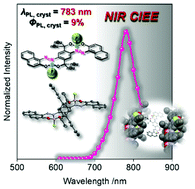Development of NIR emissive fully-fused bisboron complexes with π-conjugated systems including multiple azo groups†
Abstract
Development of novel near-infrared (NIR) emitters is essential for satisfying the growing demands of advancing optical telecommunication and medical technology. We synthesized elemental skeletons composed of robust π-conjugated systems including two boron-fused azo groups, which showed an intense emission in the red or near-infrared (NIR) region both in solution and solid states. Two types of bisboron complexes with different aromatic linkers showed emission properties with larger bathochromic shifts and emission efficiencies in solution than the corresponding monoboron complex. Transient absorption spectroscopy disclosed that the inferior optical properties of the monoboron complex can be attributed to fast nonradiative deactivation accompanied by a large structural relaxation after photoexcitation. The expanded π-conjugated system through multiple boron-fused azo groups can contribute to rigid molecular skeletons followed by improved emission properties. Moreover, the anti-form of the bisboron complex with fluorine groups in the opposite directions to the π-plane exhibited crystallization-induced emission enhancement in the NIR region. The molecular design by using multiple boron-fused azo groups is expected to be a critical strategy for creating novel NIR emitters.



 Please wait while we load your content...
Please wait while we load your content...